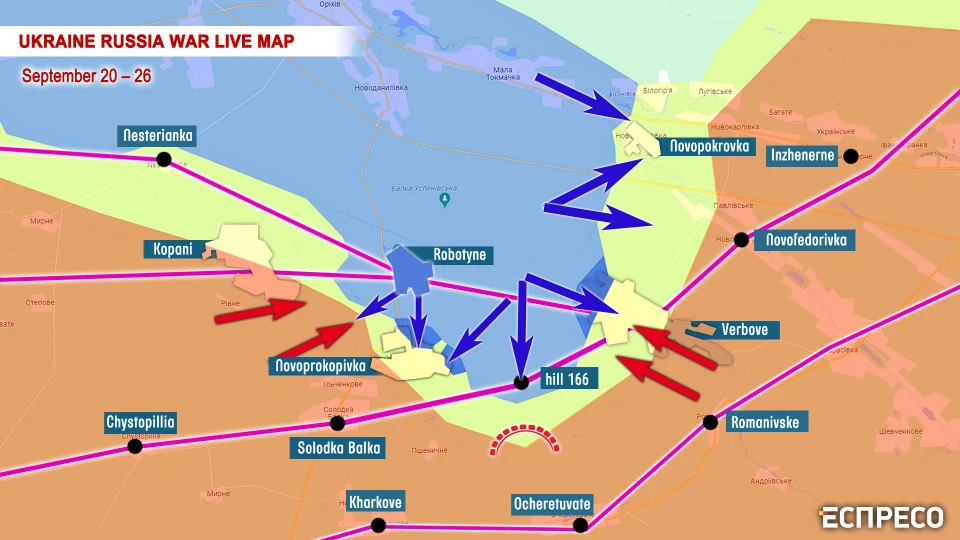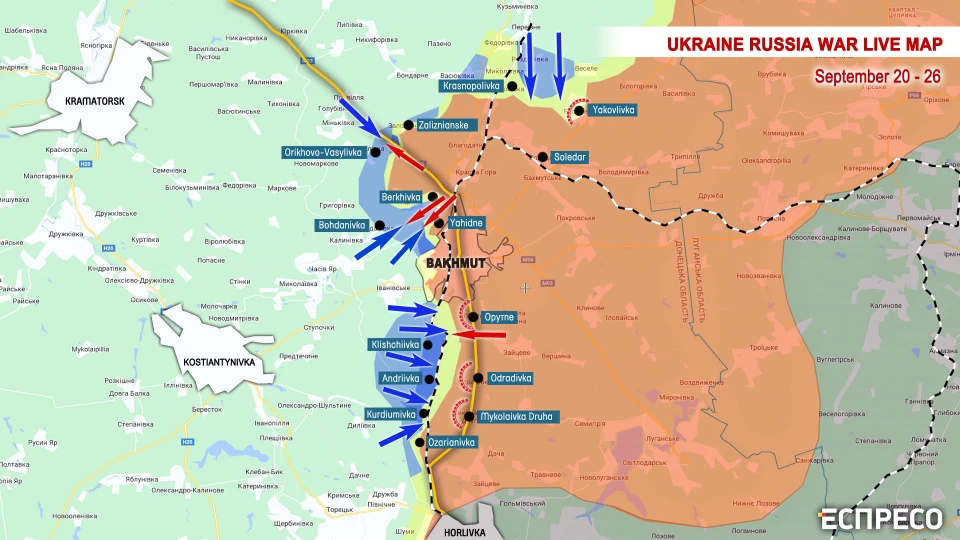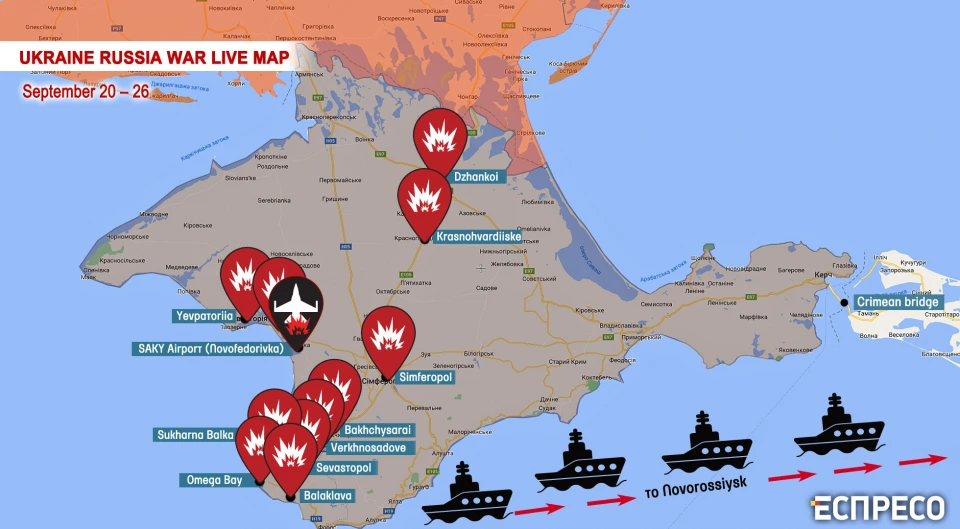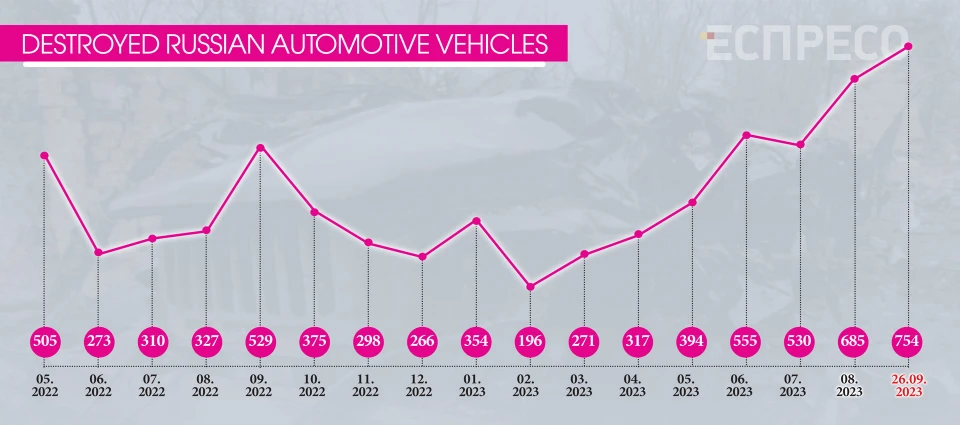
Ukraine-Russia war live map for September 20-26: Tokmak offensive and hunt for Russian commanders
The General Staff announced that the enemy had shifted to a defensive position along the entire front. Meanwhile, Ukraine’s Armed Forces have escalated their offensive in the south and maintained pressure on Russians in Crimea
Resumption of counteroffensive in Tokmak
According to the General Staff's report, the Russian forces have shifted to a defensive stance along the entire front. This is especially noticeable in the Luhansk region, where they had been trying to make advances all summer but ended up losing their ability to attack effectively, achieving no results. Consequently, some of their brigades were moved to the southern front, which is facing significant challenges.
In the Robotyne region, where the Russians had deployed a substantial number of paratroopers, our Defense Forces successfully repelled all enemy counterattacks, causing significant losses to their ranks. For instance, the 810th marine brigade was defeated near Kopani and withdrew from the front line to Tokmak, while the Ukrainian Armed Forces continued their westward advance from Robotyne. Similarly, the 108th Airborne Brigade disappeared from the front lines.

The Russian strategy was based on the assumption that marine attacks would halt or at least delay the Ukrainian counteroffensive. However, our forces bolstered their artillery capabilities and resumed their advance in the area between Verbove and Novoprokopivka. Currently, intense battles are taking place for key high points that would grant control over the lowlands extending toward Tokmak itself.
Within a week, our courageous soldiers expanded their presence to the north and east of Novoprokopivka, pushing the occupiers south of the village. In Verbove, the Defense Forces are advancing, securing the village from the north and southwest.

Staromlynivka, Berdyansk direction, Donetsk region
A few weeks ago, our Armed Forces crossed the Shaitanka River and attempted to secure villages near Novodonetske and Novomayorske. Unfortunately, they faced resistance and had to retreat to their original positions after a two-week lull. However, this week, our forces have resumed their offensive in this area, giving us hope for positive developments.
Bakhmut
The leadership of the Ukrainian Armed Forces has announced that they now control the Horlivka - Bakhmut road. President Zelenskyy has also stated that the liberation of Bakhmut, along with two other cities, is in the near-term plans. Despite these announcements, there haven't been significant changes on the front this week. Our courageous soldiers continue to advance, albeit slowly, covering several hundred meters a day under challenging conditions. Our defensive forces persist in pushing the occupiers east of the railway and launching attacks on Kurdyumivka from the north and west.

Hunting down Russian leadership
On September 20th, our missile forces targeted Verkhnyosadove village, located north of Sevastopol, where the reserve headquarters of Russia's Black Sea Fleet was situated. This strike resulted in the destruction of the military base, significant damage to valuable equipment, and the elimination of several high-ranking officers. Following this, the fleet's leadership decided to convene at the main headquarters in Sevastopol, hoping for better protection. On September 22nd, two Storm Shadow missiles struck the Black Sea Fleet commander's meeting, attended by the fleet's top brass and the Russian Federation's ground forces command on the southern front.
On September 24th, rockets struck the FSB building in Kursk and targeted the Khalino airfield in the Kursk region, coinciding with drone activity during a meeting of the aviation regiment's leadership. This attack resulted in the elimination of the regiment's commander, deputy commander, and several staff officers.
The following day, the SBU deployed HIMARS during a meeting at the headquarters of the 24th motorized rifle regiment of the 70th motorized rifle division in the Kherson region. Prior to this, the occupiers' headquarters in Melitopol had been destroyed.
Given the significant demoralization among ordinary Russian troops, the elimination of their leadership is likely to create considerable chaos within their ranks, potentially impacting the situation on the front lines.

Russian energy terrorism resurgence
Following the destruction of military targets, the occupiers resumed terrorist attacks on energy infrastructure. On the night of September 21, an energy facility in the Rivne region was hit, causing power outages in several districts of this region and the neighboring Zhytomyr region. A total of 43 missiles were launched, with 36 intercepted by our air defense, including 20 over Kyiv. Additionally, Russian missiles struck regions including Lviv, Cherkasy, Dnipropetrovsk, Odesa, and Kharkiv.
It's important to highlight the retaliatory strike by the Ukrainian Armed Forces on a large ammunition warehouse near the city of Sorokyne, near the border of Luhansk region and the Russian Federation. Explosions were also reported in the center of Donetsk on September 26.

The battle for Crimea
After breaching the enemy's air defenses in Crimea, Ukraine’s missiles and drones maintained continuous activity. On September 20, they targeted the air base in Saky, which housed approximately 12 Su-24 bombers, Su-30 fighters, and at least one Pantsir air defense system. A training center where Iranians trained Mojaher UAV operators was also struck. Throughout the week, explosions were reported in various locations, including Dzhankoy, Bakhchisarai, Simferopol, Rozdolne, Krasnohvardiysk, Verkhnyosadove, and Sevastopol. The latter included the fleet headquarters and Sukharna Balka, possibly used to hide enemy ships. The Crimean bridge faced multiple blockades.
As a result of these successful attacks, the Russian fleet retreated from Crimea to Novorossiysk.

New records in eliminating Russian forces
September isn't over yet, but the Ukrainian Armed Forces have achieved several significant records in enemy elimination, underscoring the success and strategy of the counteroffensive. Artillery losses have continued to mount, reaching 769 units as of September 26. Additionally, 754 units of vehicles and fuel tanks were destroyed through strikes on enemy logistics.

The maps were created based on information received from the General Staff of the Armed Ukrainian Forces, as well as other open and verified sources. However, the maps are not completely accurate and only conditionally reflect trends in the combat zone.
- News













































